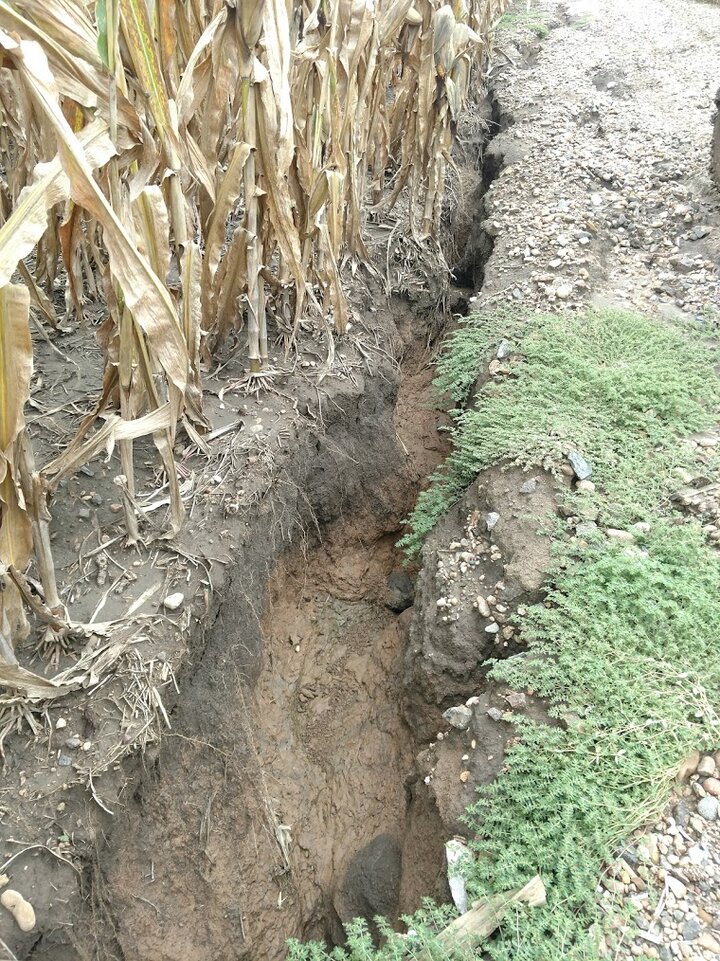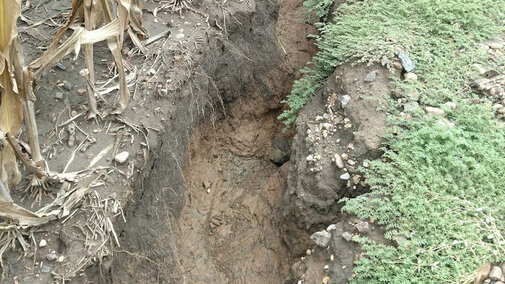
Michael Sindelar, Extension Cropping Systems Educator in Clay, Fillmore, Nuckolls, and Thayer counties: Fillmore and Clay counties received an average of 6 inches of rain in the last couple of weeks and have had unseasonably cool temperatures. Because of this I have seen an increase in stem and root rots in soybeans. I diagnosed two fields postmortem and the cause appears to be Phytophthora. There are still a number of lowland fields that have water standing and soils are still very close to field capacity. Figure 1 shows a no-till field along the irrigation access road. The soils in the county were close to saturation before the rains on Sept. 3. This created optimum conditions for soil erosion in sloping areas. (9/11/18)
Randy Pryor, Extension Educator in Saline County: A sample was received from southern Gage County with suspected western bean cutworm, but Bob Wright verified it was corn earworm and earworm damage. About 5.5 to 6.5 inches of rain fell in most of Saline County. Heavy rain fell in Jefferson and Gage counties too. The rain greened up cool-season pastures, filled up farm ponds, overflowed Turkey Creek, and will have a very positive effect on dryland soybean yields throughout the area, especially effecting soybean seed size. With these heavy rains, irrigation is complete for the year. A good share of the corn has black layered or will be black layering this week.
It's been a good crop season. Early conditions led to excellent crop emergence scores with field corn and we were spared from severe weather with hail. One wind event did cause some green snap earlier in the year which really varied depending on the corn variety and stage of development. We have been fielding some calls on where to price cereal rye cover crop as its popularity as a cover crop continues to increase in southeast Nebraska. Not very much harvesting if any at all will occur in the area during HHD this year. (9/11/18)
Nathan Mueller, Extension Cropping Systems Educator in Dodge and Washington Counties: Soybeans in this area will be ready to harvest later this week. Seed corn harvest is mostly done. Some was harvested when fields were pretty muddy, causing concern for possible compaction. Some corn is not far from ¾ milk line. Stalk quality is deteriorating rather quickly and will be a problem if we get strong winds on some of these fields which would need to be harvested early. I’m working with quite a few growers interested in growing wheat and cover crops for the soil health benefits. Other than dectes stem borer and the soybean gall midge, we’re not seeing a lot of insects. (9/11/18)
Gary Stone, Extension Educator in Scotts Bluff County: Overall crops are looking good and the weather has been great for those who missed the hail. Dry beans are turning at a fantastic rate and hopefully a lot will be harvested without getting rained or hailed on. Corn is looking good, there will be an early harvest of sugar beets, and winter wheat planting has started on the table. (9/11/18)
John Wilson, Extension Educator in Burt County: We’re good on moisture for the rest of the season with hopefully some to carry over into next spring. Crops are maturing rapidly, silage is cut, and high moisture corn is coming out. Beans are probably two-thirds to three-fourths turning, and a few are dropping their leaves. If it stays warm and breezy, fields will probably be ready for harvest within the week. No real problems to report, although some growers are starting to report stalk rots. Hopefully it will be breezy enough for good drying, but not so breezy as to push over plants compromised by stalk rot. (9/11/18)
Paul Jasa, Extension Agricultural Engineer: At the Rogers Memorial Farm we’re tossing a coin as to whether beans, corn, or sorghum will be ready to harvest first. Late season waterhemp is poking through. Where we have cover crops following wheat, we’re seeing far fewer weeds. (9/11/18)
Todd Whitney, Extension Educator in Phelps County: We had over 5 inches of rain in some areas and much less in others. Silage harvest was delayed and they’re trying to get in now and harvest high moisture corn. (9/11/18)

